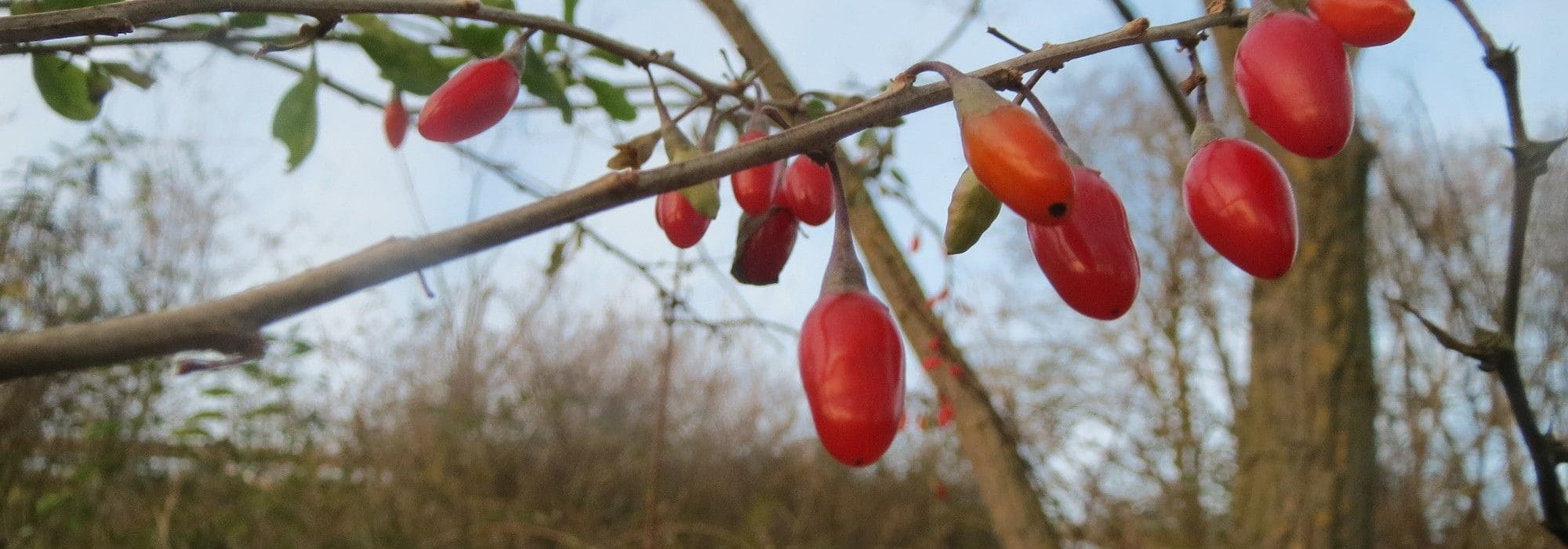
Wolfberry: planting, care, and harvesting goji berries
Contents
Wolfberry in a nutshell
- The Chinese wolfberry or Goji berry (Lycium barbarum) is a bush from the Solanaceae family that is very ramous and slightly thorny.
- The berries it produces from August to October are known as Goji berries, considered super fruits.
- Hardy down to -20 °C and drought-resistant, the carbary Wolfberry adapts to all soils, including calcareous or saline.
- It can be used in a fruit or defensive hedge, in shrub borders, or trained against a wall.
- Its maintenance consists of a light pruning once a year and the addition of organic matter in spring.
A word from our expert
We all know about Goji berries, which have been trendy since the 1990s, as these small orange-red berries, consumed dried, are packed with superpowers. But did you know that these drupes are harvested from the Barbary Wolfberry, a shrub with an upright habit, highly branched and slightly thorny? A member of the Solanaceae family (like potatoes and tomatoes!), the Barbary (or Chinese) wolfberry (Lycium barbarum) never exceeds 3 metres and forms a vigorous shrub that is easy to integrate into a fruit hedge alongside blackberries and raspberries, or even as a defensive barrier. With its flexible branches, it can also be trained. Moreover, it has a fairly rapid growth rate.
From April to September, depending on the cultivars, the Chinese Wolfberry is covered in small purple to mauve flowers, simple, elliptical and lanceolate, resembling funnels. Then, from late August until the first frosts, the berries appear. Known in traditional Chinese pharmacopoeia, they can be consumed fresh or dried. Rich in antioxidants, vitamins, and trace elements, this Goji berry is considered in China as the “fruit of happiness.”
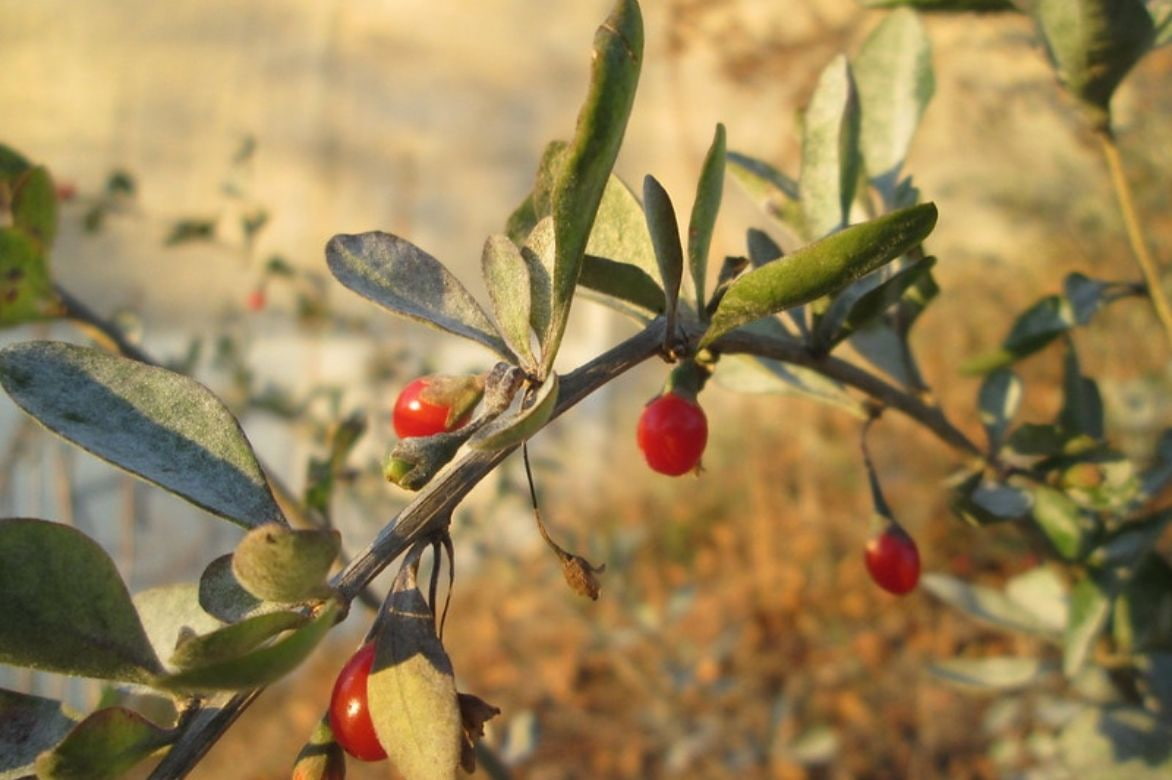
Goji berries are very rich in antioxidants and vitamins, especially when consumed fresh
The Barbary Wolfberry has its place in all gardens across all climatic zones. While it prefers alkaline soils, it adapts to all situations, provided the soil is well-drained. Hardy down to -20 °C and drought-resistant, the Barbary Wolfberry can even thrive in saline soils, by the sea. As for the care it requires, it is minimal: an annual pruning to remove dead wood and help it develop a compact habit, and a yearly application of compost.
If you haven’t already, adopt this small deciduous shrub that, as it matures, will produce an abundance of berries.
Botanical description
Botanical data
- Latin name Lycium barbarum syn. Lycium halimifolium
- Family Solanaceae
- Common name Chinese wolfberry, Goji berry, Matrimony vine, Common lycium, Halimione-leaved lycium
- Flowering summer
- Height up to 3 metres
- Exposure full sun or partial shade
- Soil type ordinary but well-drained
- Hardiness down to -20°C
Lycium barbarum is a bush in the Solanaceae family, widely distributed across Europe and Asia. While it has long been thought to be native to China, the etymology of its name tends to cause confusion. “Lycium” indeed means “thorny shrub of Lycia,” with Lycia being an ancient province of Asia Minor, while “barbarum” refers to Barbary, a term denoting the Maghreb. Nevertheless, the Goji berry is well-known for its medicinal berries in both ancient Chinese and European traditions. The berries are called “ningxia gou-qi-zi” in Chinese, meaning “Lycium of Ningxia,” with Ningxia being a province in north-west China where the cultivation of Lycium is traditional. This region, along with parts of Tibet and Inner Mongolia, has been a primary area for Goji berry production for over 600 years. In 1730, the Goji berry was introduced to England, somewhat by mistake, as it was believed to be a tea plant. Later, it became widely naturalised in southern and central Europe, but its medicinal properties were forgotten.
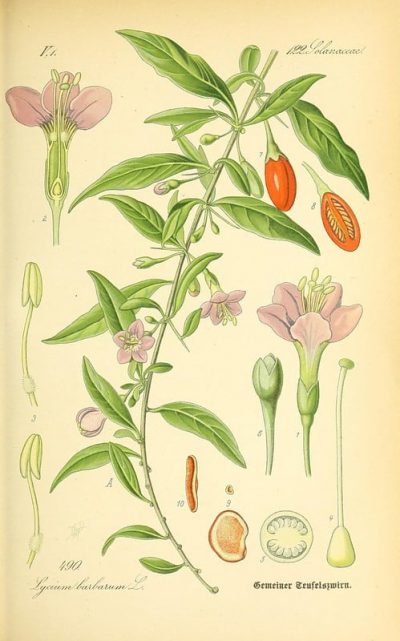
Botanical illustration
In the 1970s, Bradley Dobos, an American ethnobotanist turned Tibetan doctor, named the wild berries growing on the Goji berry bush. In the 1990s, with China’s economic rise, Goji berries began appearing in Western organic shops. They are now considered superfoods, with some claiming they are among the most nutritious fruits. Legend even has it that centenarians in Tibet consume a handful daily!
In the wild, the Goji berry thrives in arid and semi-arid regions, temperate zones, and coastal areas, on poor and porous soils, in clear and warm spots. It can also withstand very low temperatures. It is found from Eurasia to North and South America, from Australia to southern Africa.
This bush has an upright, flexuous, and spreading habit. It features a woody climbing stem and shallow roots, forming relatively slender, pendulous, and slightly angular branches. Its relatively flexible stems allow for training. They are equipped with thorns of varying lengths.
The Goji berry bush displays deciduous foliage that is quite thick and leathery, changing from bright green at first to grey-green at maturity. The simple leaves, solitary or fasciculate, grow along the branches. They are narrowly elliptical-lanceolate, broader at the base, measuring around 2 to 3 cm. With a short petiole, they are glabrous and sprinkled with prominent secondary veins.
From April, but especially from June to September, tiny flowers bloom in shades ranging from violet-pink to purple. These small hermaphroditic flowers are tubular and resemble a funnel or trumpet. Campanulate and star-shaped with five lobes, they are slightly reflexed and have a wavy margin. Solitary or grouped in clusters of 2 to 5, they feature two dentate lobes and measure about 10 mm long. They emit a delicate fragrance and are nectariferous for bees and other pollinating insects.

The flowers of the Goji berry range from violet-pink to purple
After the flowers (often simultaneously), berries develop from July until the first frosts of autumn. These berries ripen gradually, changing from green to bright red or orange. Be cautious, never harvest green Goji berries as they are toxic due to their saponin and solanine content. Goji berries are only edible when fully ripe, meaning they should be well-coloured and tender. Oblong in shape, they measure about 18 mm in length. Each berry contains around twenty small flat seeds. If the growing conditions are right, the Goji berry bush produces berries from the second or third year, typically more from the fourth year onwards. This production only increases over time. These berries are both sweet and tangy.
Hardy down to -20 to -22°C, the Goji berry bush does require warmth to produce sweet berries. It is also sensitive to frost when young and has not formed wood. Additionally, it needs 180 frost-free days to develop its berries properly. However, like in its natural habitat, it enjoys marked temperature fluctuations.
This bush is particularly valued for the coexistence of purple flowers, green berries, and fully ripe, orange-red berries.
The different varieties of Barbary Goji berries
If Lycium chinense is widely found throughout Eurasia, in Europe, Lycium barbarum is the most common. There are also a few varieties that are very easy to grow in our gardens. For instance, ‘Princess Tao’ is a French selection, particularly interesting for the exceptionally sweet flavour of its berries. It is a very powdery mildew-resistant variety of Goji. ‘Instant Success’ also deserves a place in our gardens. This variety is notable for fruiting in the first year. Its berries are quite sweet with a hint of acidity.
Our favourites
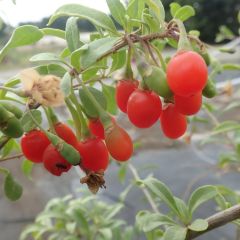
Lycium barbarum Gojidelys
- Flowering time July, August
- Height at maturity 1,50 m
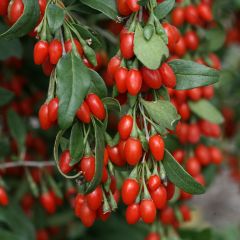
Lycium barbarum Sweet Lifeberry
- Flowering time July, August
- Height at maturity 1,50 m
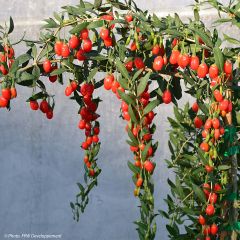
Lycium barbarum Princess Tao FPW03
- Flowering time July, August
- Height at maturity 1,50 m
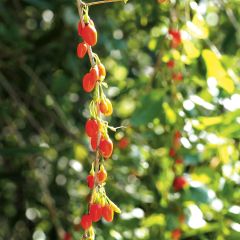
Lycium barbarum Instant Success
- Flowering time July, August
- Height at maturity 1,50 m
Discover other Goji berry bush
View all →Available in 0 sizes
Available in 1 sizes
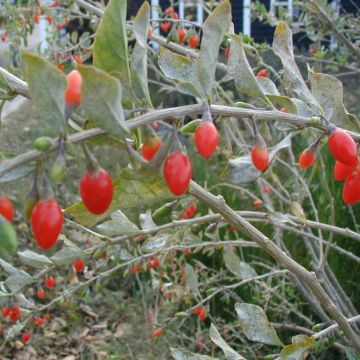
Available in 2 sizes

Available in 1 sizes
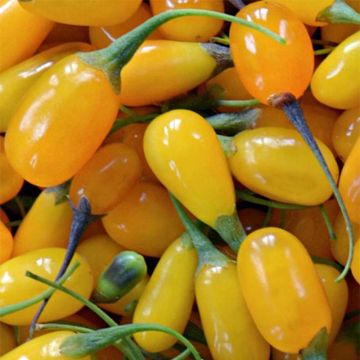
Available in 1 sizes
Available in 1 sizes

Available in 1 sizes
Available in 1 sizes
Available in 1 sizes
How, where, and when to plant the goji berry bush?
Where to plant?
In its natural habitat, the Barbary Wolfberry grows in poor, inhospitable soils and sometimes at high altitudes. It has developed adaptability and resilience to various environments. It thrives in all types of soil, including dry, ordinary, low-nutrient, or calcareous, even saline soils. However, it does not appreciate wet, clayey, and heavy soils at all. Good drainage is therefore essential for obtaining a vigorous Barbary Wolfberry. Additionally, the richer the soil, the more abundant the fruiting will be.
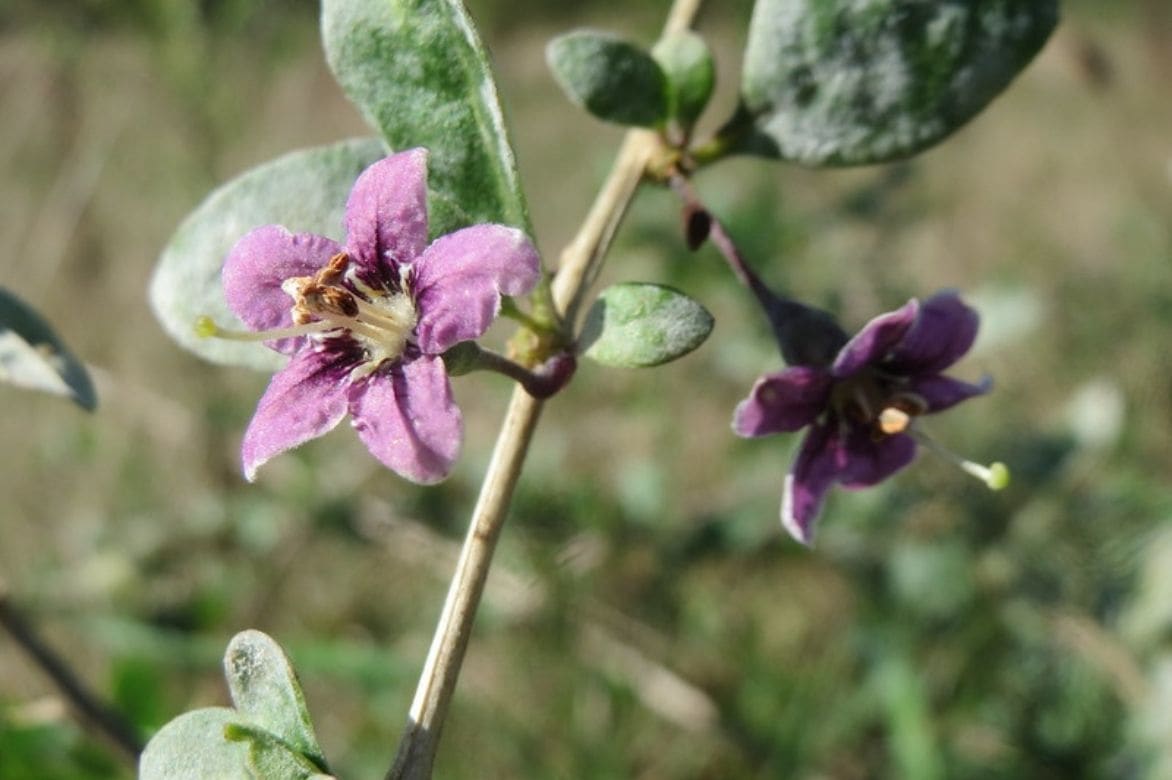 In full sun and in ordinary, well-drained soil, the Barbary Wolfberry flowers and fruits better
In full sun and in ordinary, well-drained soil, the Barbary Wolfberry flowers and fruits better
Regarding its location, the Wolfberry is again not very demanding. Although it prefers full sun, it can also be planted in partial shade. The more it benefits from UV rays, the more it will fruit. Moreover, it is capable of withstanding drought.
When to plant?
Ideally, the Barbary Wolfberry should be planted in autumn, outside of frost periods. The period from October to December is suitable for planting. It can also be planted in spring, in March or April, but it will have less time to establish itself before the summer heat.
How to plant?
- Dig a hole 50 cm deep and wide
- Place a layer of gravel if your soil is too heavy
- Mix the extracted garden soil with some potting soil and crushed horn. Add a bit of sand if your soil is too compact.
- Position the Barbary Wolfberry and fill the hole
- Firm the soil and water generously.
If you are planting several Wolfberries, space them at least 1 metre apart.
The Barbary wolfberry is also very easy to grow in a pot. It can remain outside or inside at a temperature between 15 and 25 °C. When grown in a pot, the Wolfberry rarely exceeds 1.50 metres in height.
- In a pot 30 to 40 cm deep and wide, place clay balls.
- Fill your pot with a mixture of garden soil, potting soil, and sand.
- Plant and firm the soil
- Water generously.
Read also
5 red berries for beginnersWhat to pair with the Barbary wolfberry?
Lycium barbarum is ideal for a fruit hedge alongside raspberries, blueberry bushes, blackberry brambles producing beautiful blackberries, blackcurrant bushes, and redcurrant bushes… It can also be paired with a serviceberry or a sea buckthorn, or more unusually, a casseille.
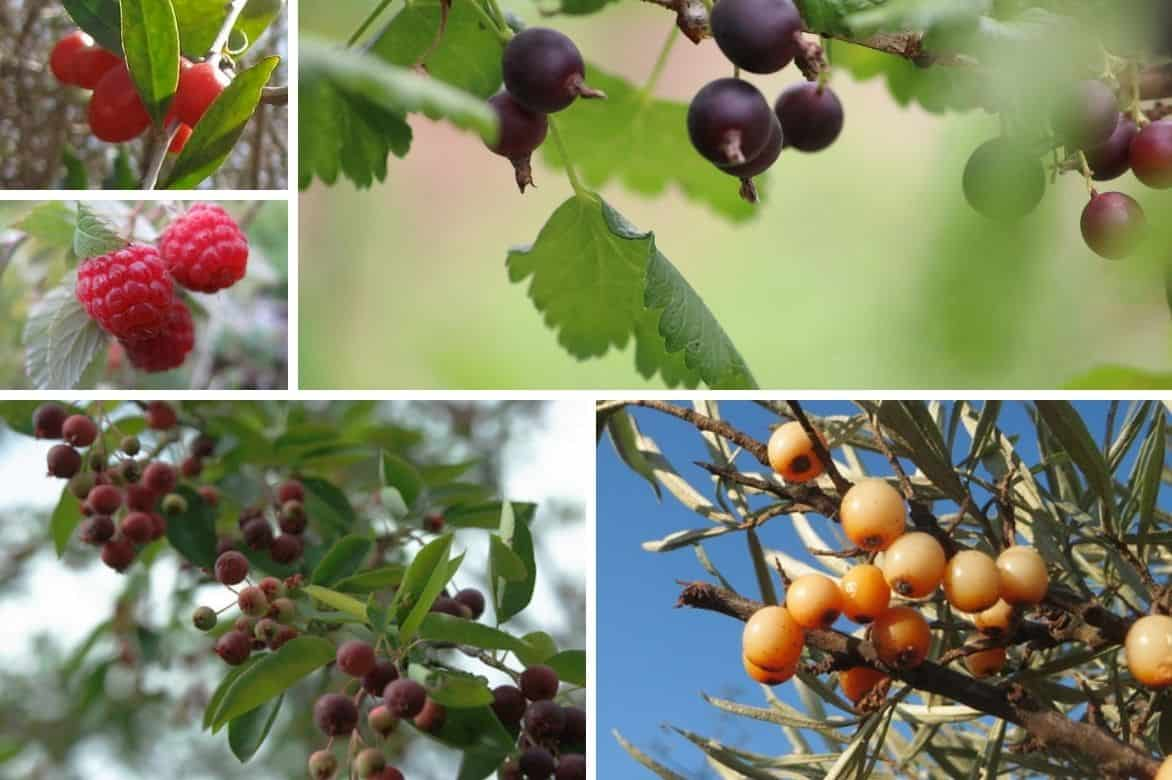
To create a fruit hedge, plant a Barbary lycium, a raspberry, a serviceberry, a sea buckthorn, and a casseille
Caring for Barbary wolfberry
Low maintenance in terms of soil or location, Barbary wolfberry is also easy to care for. In the year of planting, weekly watering will be necessary. After that, it manages on its own except during dry periods when weekly watering is recommended. Applying mulch helps to space out watering. However, if the Wolfberry is grown in a pot, it will need watering every 3 days in summer, and once a week thereafter.
Once a year, at the beginning of spring, adding compost or organic fertiliser will be beneficial.
As for pruning, it consists of removing dead branches in spring. This light pruning will also encourage fruiting. However, wolfberry tends to produce long, thin stems. To remedy this, at the beginning of summer, pinch the main stems and the top of the bush a few centimetres below the apex. This pruning allows the bush to produce new branches and become more compact.
Training Barbary wolfberry
When wolfberry reaches 1 metre in height, it can be trained against a south-facing wall. This operation takes place in July.
- Plant 2-metre tall stakes
- Install wires in three rows, the lowest at 80 cm from the ground
- Twist the longest branches of the Wolfberry around the wires. Avoid tying them, as the natural arch of the Wolfberry makes this task much easier.
- Prune a few branches to allow air circulation around the Wolfberry.
Diseases and pests of Goji
Little susceptible to diseases, Goji berry can, however, be affected by powdery mildew, a fungal disease also known as white disease. Indeed, it is recognised by the white fluff that appears on the surface of the leaves, and sometimes on the flowers and fruits. It develops in warm weather with high humidity. Powdery mildew can be treated by spraying a horsetail manure or a mixture of half a litre of milk with 4 litres of water.
It is mainly the small pests that one should fear when Barbary Goji is young. Aphids can be eliminated with a solution made from black soap. Slugs attack the lower branches, which can simply be raised or supported. Voles also appreciate this bush. The only solution lies in adopting a cat!
Propagating Barbary wolfberry
Barbary Goji multiplies quite easily and by several methods: sowing, propagation by cuttings, or layering.
Sowing
Sowing is done in spring. Two techniques can be used:
- Place the seeds between two absorbent papers that are dampened, and as soon as germination occurs, plant them in the soil.
- Sow the seeds directly in a light substrate that is kept continuously moist at a temperature between 20 and 28 °C.
Germination occurs within 3 to 15 days. After that, transplant while keeping the soil around the roots.
Propagation by cuttings
At the beginning of spring, during pruning, take a branch of 3 to 4 cm. You can also do this with the tip that has been pinched. Remove the lower leaves and keep only two or three at the top. Place this cutting in a light substrate and spray with water. Surround the pot with plastic film or an inverted plastic bottle during the estimated rooting period of 3 weeks.
Layering
As the Goji has a flexible habit and flexuous branches, it is easy to layer. Simply bend a branch towards the ground and bury it in light soil. When the layer has taken, use a spade to separate the new plant from the mother plant for replanting elsewhere. Additionally, natural layering is common.
Harvesting and storing Goji berries
The harvest of Goji berries takes place from July until the first frosts. They can be picked one by one when they are bright red and tender. Alternatively, you can shake the bush after laying down a white sheet. Only the ripe berries will fall.
Harvesting can be done as needed, every 4 to 6 days.
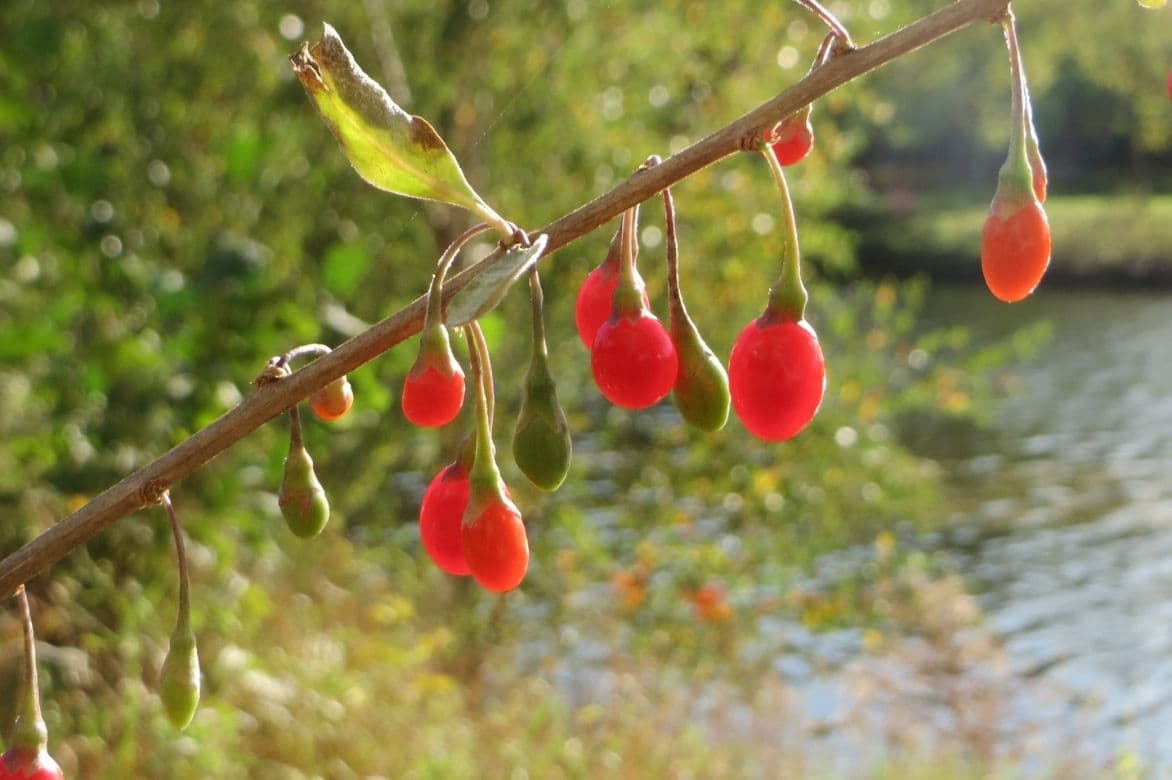
The harvest of Goji berries is done as needed when they are red and tender. Note that green berries are toxic.
In the first year, the harvest is minimal. In the second year, if the growing conditions are good, you can expect 500 g per plant, double that the following year, and around 1.5 kg in the fourth year. After about ten years, a plant can produce up to 5 kg of Goji berries.
As a reminder, green Goji berries are toxic.
Goji berries can be consumed fresh for 3 days after harvest. They can also be dried using three methods:
- in the open air and in full sun, on trays that should be brought inside at night. Traditional drying takes several weeks.
- in a dehydrator for 12 to 24 hours, as Goji berries are high in water content.
- in an oven at less than 40 °C, with the door open. Ensure the berries are spread out without touching each other and check the drying state after about ten hours.
Once dried, Goji berries can be stored for several months in an airtight container. They can be enjoyed as they are or rehydrated in water, a plant-based drink, or fruit juice. They can also be added to desserts.
→ Read also: Harvest and store your Goji berries: a treasure trove of vitamins within easy reach.
The virtues of goji berries
Goji berries are known for the antioxidants they contain. In fact, they are one of the most vitamin C-rich foods after orange, acerola, and just below sea buckthorn when consumed fresh.
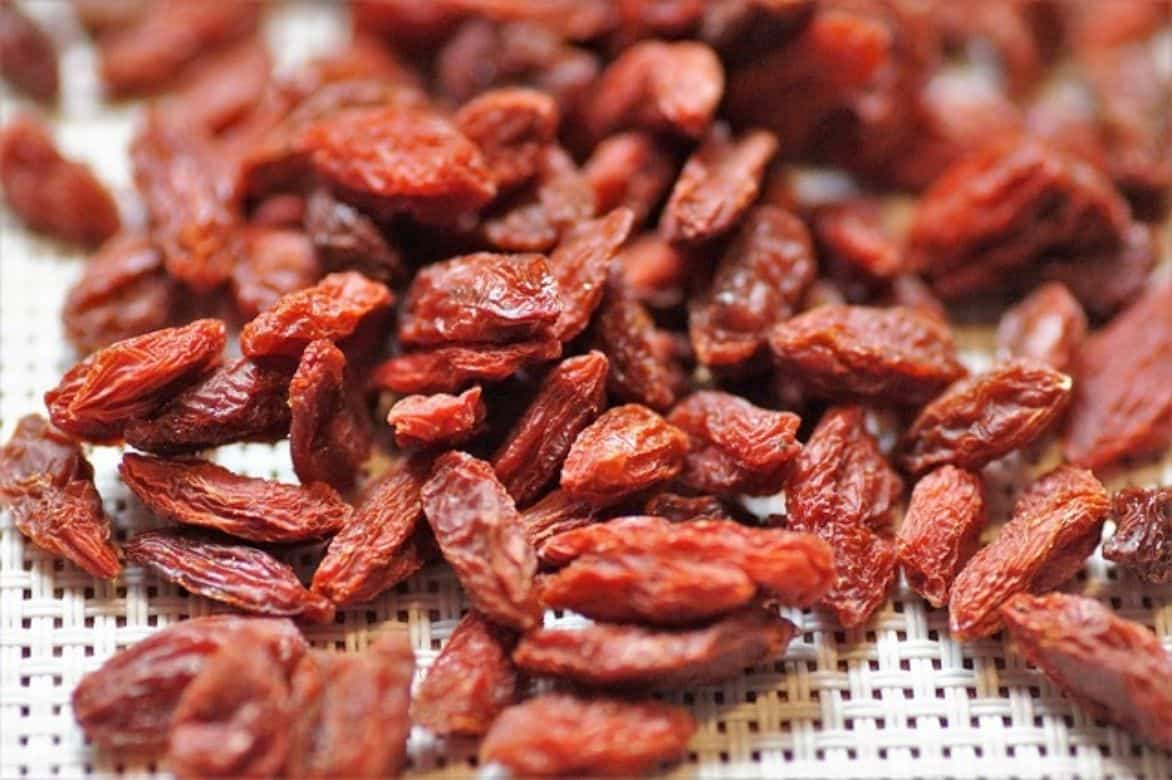
Goji berries can be dried on racks, in a dehydrator, or in an oven at very low temperature.
They are also good sources of vitamins B1, B2, B6, and E, beta-carotene (as much as carrot), proteins, amino acids, and trace elements such as zinc, iron, selenium, phosphorus, and copper.
However, we cannot guarantee anything regarding their ability to ensure eternal youth!
Useful resources
- If you want to integrate your Goji bush into a productive hedge, discover all our bush options that combine the useful with the pleasant
- Want to propagate your Chinse wolfberry ? Alexandra explains the different techniques
- Prefer layering? Alexandra also explains how to do it.
- Learn more with Pascale on the blog: Growing superfruits is possible
- Also discover the Synsepalum dulcificum or miracle fruit!
- Subscribe!
- Contents






























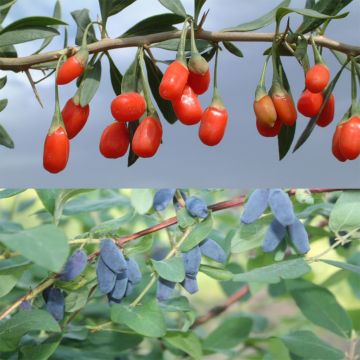
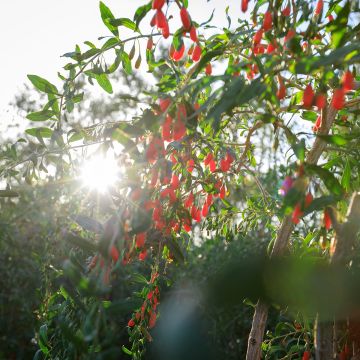

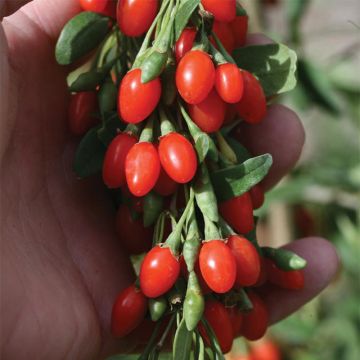

Comments